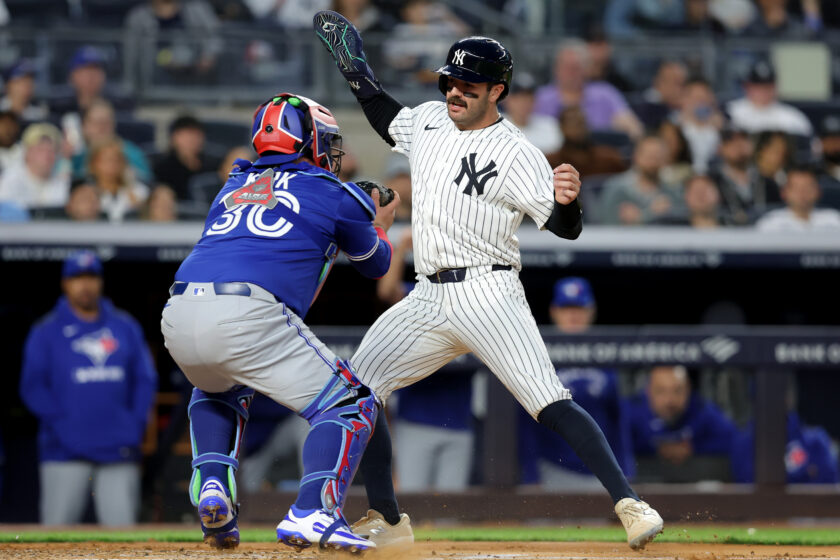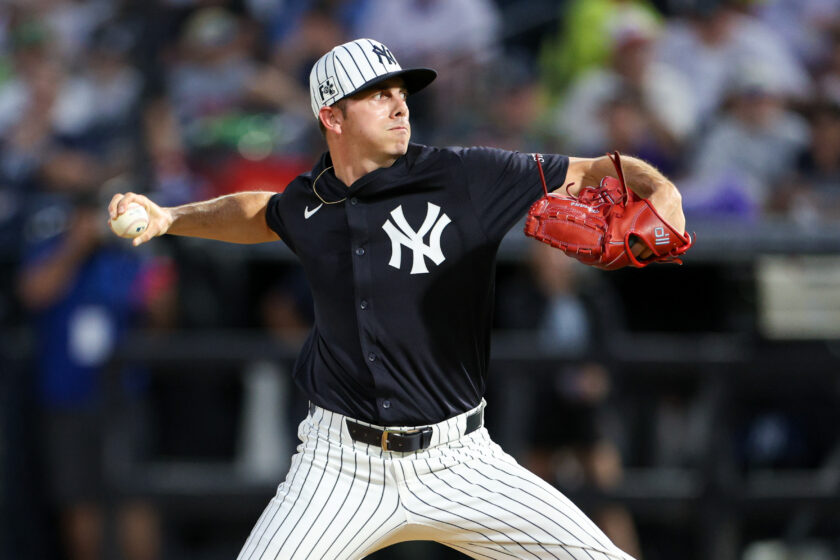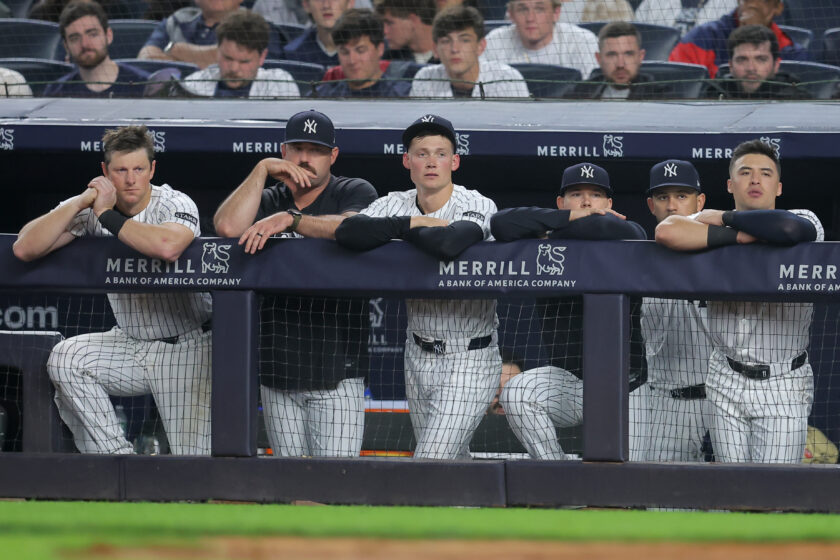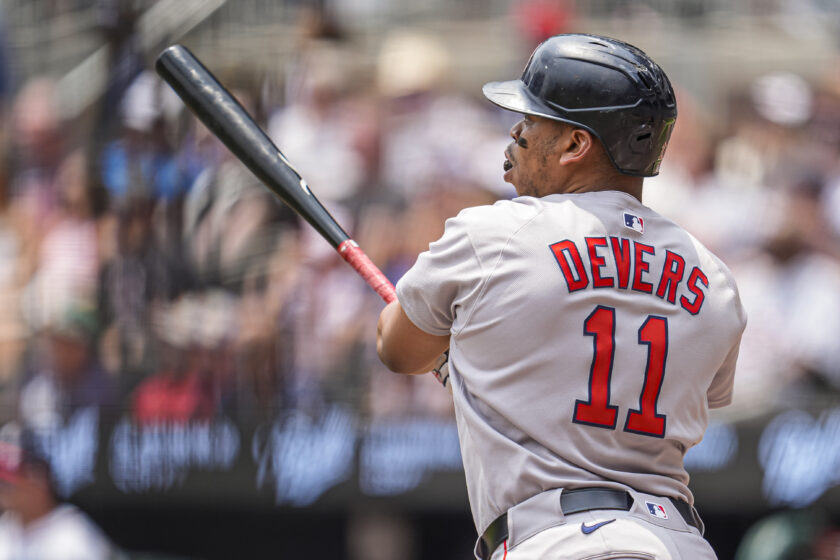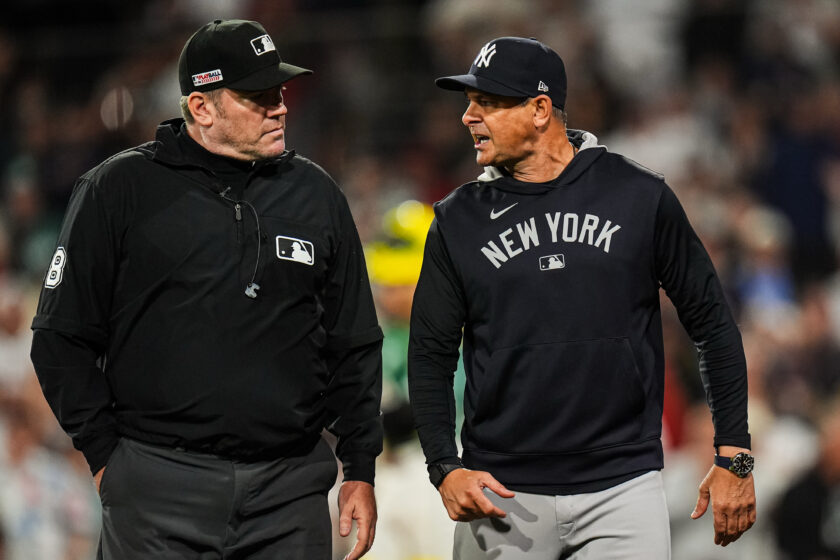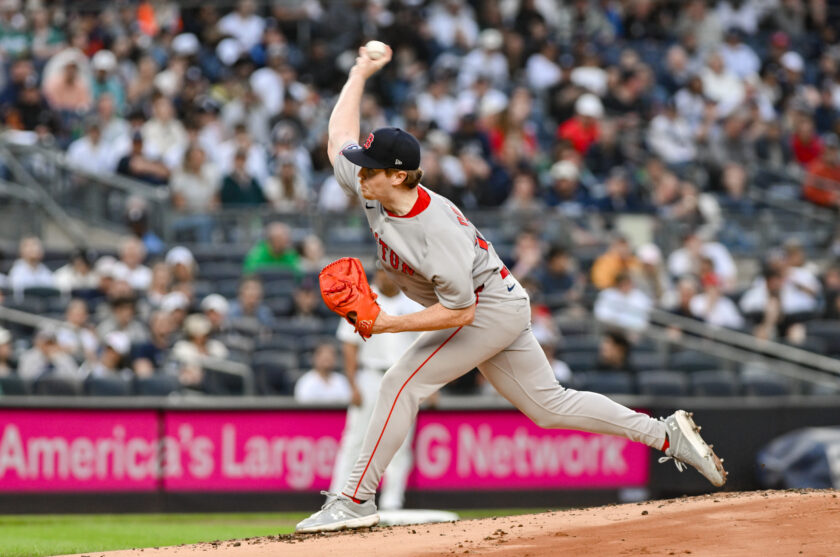The New York Yankees Are Fading Amidst a Crumbling Roster
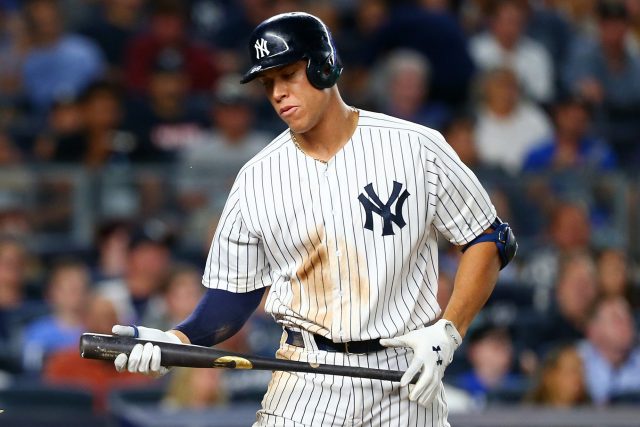
The New York Yankees entered this past weekend with a chance to draw closer to the Boston Red Sox. Instead, they exit the series broken, battered, and fading.
[dropcap]A[/dropcap]fter a sacrifice fly from Todd Frazier in the eighth inning, the New York Yankees were heading into the ninth last night with a 2-1 lead and a chance to take two out of three from the Red Sox to draw to 3.5 games back of Boston for the division lead.With one out in the top of the ninth, after closer Aroldis Chapman smoked Hanley Ramirez on several fastballs that notched triple digits, rookie infielder Rafael Devers blasted a towering offering over the left centerfield wall to tie the game, one Boston would eventually go on to win in the tenth after a go-ahead RBI single from rookie Andrew Benintendi, who totaled nine RBI in the series, including two three-run homers on Saturday off Luis Severino, the first rookie to accomplish the feat against the Yankees in baseball history.
Red Sox-Yankees never disappoints. pic.twitter.com/4A3FeUuCgF
— ESPN (@espn) August 14, 2017
Devers’s fourth home run of the season was an historic one: according to Bleacher Report and Statcast, the speed of Chapman’s pitch—102.8 MPH—was the fastest a ball was hit for a home run since 2008, when Statcast first started developing records of such tracking.
This guy’s reaction on Twitter says it all:
Sneak peak to tonights reaction. #Chapman vs devers 2 strikes 1 out.. the stadium as electric as its been all year until….#yankees #RedSox pic.twitter.com/DEy83luDNN
— JoezMcfly🇩🇴 (@JoezMcfLy) August 14, 2017
The blown save from Chapman was his fourth of the year. He was also tagged with the loss because he pitched the tenth and one of his base runners, whom reliever Tommy Kahnle inherited, ultimately scored.
Prior to last night, Chapman had converted three-of-three save opportunities in his last five appearances, sporting a 1.59 ERA over 5 2/3 innings. He had zero blown saves in ten straight appearances, mustering an 11:5 K/BB ratio. With Dellin Betances (who boasts a 0.61 in the season’s second half, including holding batters hitless in four August appearances), David Robertson (who allowed his first walk last night since his return to the Yankees), and Tommy Kahnle (who has a 1.80 ERA/226 ERA+ in his time with the Yankees, including 14 Ks in 10 IP), Chapman was emerging as the anchor to the Yankees’ bullpen.
Alas, that no longer appears to be the case: on the season, Chapman has yielded a disappointing 3.48 ERA and 1.31 WHIP, despite a 12.8 K/9 IP ratio. In spite of his Mariano-esque brilliance of last year, Chapman is no longer in the class of lights-out relievers that have catapulted the Dodgers (Kelly Jansen) and the Red Sox (Craig Kimbrel) to remarkable heights. A move away from the closer’s spot may be in order should Chapman continue to falter, especially since Betances and Robertson both have experience closing out games.
Given a campaign that helped end a 108 year long title drought for the Cubs, Chapman looks to be suffering a World Series hangover in the midst of a rebound year from an otherwise taxing season: his 73 2/3 innings pitched (including the postseason) were the most of Chapman’s career, 15 2/3 of them coming in the crucible of a title-run with a club desperate to exorcise what cursed them for over a century.
And although the Cubs ultimately won Game 7 of the World Series in Cleveland, Chapman, appearing in his third straight game in the series, coughed up a game-tying, two-run homer—the first homer he gave up since June 18—off the bat of Rajai Davis in the bottom of the eighth, this, after pitching four total innings in Games 5 and 6. While brilliant in those four innings, manager Joe Maddon‘s use of Chapman in Game 7 may have been enough to take the edge off of who Chapman would later become in his second stint with New York: a highly paid, somewhat pedestrian closer whose contract is predicated more on the ability of his blistering fastball and less on his regular season performance in the past.

There is no wonder why the Yankees re-signed Chapman to a five-year, $86 million pact after a midseason trade sent him to the Chicago Cubs for a package that included top Yankee prospect Gleyber Torres: he had 36 saves with a 1.55 and a 0.86 WHIP with New York and Chicago, to go with an ERA+ mark of 278, the best of his career (his ERA+ of 414 in 28 regular season appearances with the Cubs was otherworldly despite a relatively humbling showing in the 2016 playoffs: he allowed 7 earned runs in 15 2/3 innings).
While he is only 29 and can still push the radar gun to substantial limits, Chapman has admittedly fallen out of favor of late with the Yankees, who have blown 20 saves on the season and are 13-21 in one-run games. Five of those blown saves are at the hands of Tyler Clippard, who departed in the trade that brought Todd Frazier, Robertson, and Kahnle to the Bronx. Because of Clippard’s markedly better numbers with the White Sox (two saves and a 1.80 ERA in 10 IP), he has since moved on to Houston to hopefully galvanize their shoddy bullpen.
Had the Yankees converted at least half of those save opportunities, New York would be standing at 71-45, good for the second-best record in the American League. Alas, “coulda, shoulda, woulda” scenarios will only get the Yankees so far, as they are now 4-8 in the month of August with consecutive series losses to the Blue Jays and Red Sox prior to their four-game, home-and-home Subway Series with the Mets.
A four-game sweep of the floundering Mets, who have actually enjoyed positive results from call-ups Amed Rosario and Dominic Smith, the two top prospects in their farm system, could be just what the Yankees need in the way of momentum prior to a highly-anticipated rematch with the Red Sox in Fenway this weekend, although, given Chapman’s woes and a faltering lineup, that is no guarantee.
Unfortunately, the second-half swoon has not been just about a Jekyl and Hyde bullpen or a withering lineup.
Via Twitter, River Avenue Blues writer Katie Sharp proclaimed a number of woes around Luis Severino’s performance on Saturday, arguably the worst of his career:
- Since the All-Star break, Severino yielded five runs in 32.1 IP. On Saturday, he yielded five alone in the third inning, much in part to Todd Frazier’s fielding error on a sure-fire double play ball (although Severino was responsible for two lead-off walks to start the frame).
- He was the first Yankee starter since Andy Hawkins on July 5, 1989 to allow 10 or more runs in fewer than 5 IP at Yankee Stadium.
- He was the first Yankee starter in 100 years to surrender 10 or more runs in fewer than 5 IP against the Red Sox.
While he is still the ace of the Yankee rotation, Severino dropped well below the tier of top-flight AL pitchers that includes Corey Kluber and Chris Sale, who was masterful against the Yankees last night, to the tune of 12 Ks over seven innings of one-run ball (although he was matched over 5 1/3 innings by emergency starter Jordan Montgomery, recently demoted to Scranton/Wilkes Barre, a move likely struck to limit his innings).
The Yankees desperately needed Severino to be his post All-Star break self, only to endure rabid disappointment, more so considering a thrilling eighth inning on Friday that gave the Yankees an improbable 5-4 win in which the Yankees trailed 3-0 going into that eighth frame.
[sc name=”Yankees Center” ]Unfortunately, the Yankees call on struggling arms in Luis Cessa, who goes tonight against the Mets, and Caleb Smith (if necessary) while CC Sabathia and Masahiro Tanaka hit the DL (with a knee injury and right shoulder inflammation respectively). Had Brian Cashman not orchestrated deals for Gray and Jaime Garcia, the Yankees could truly be in dire straits, although now, the rotation finds itself presently taxed in service of an unsettled bullpen that, according to manager Joe Girardi, still features Chapman as the closer.
On the other hand, the Yankee lineup, despite featuring seven players with double digit homers and three players with a WAR over 3.0 (Aaron Judge, Aaron Hicks, and Didi Gregorius), has been a relative culprit for their second half swoon, especially in situations with runners on-base and in scoring position.
According to Team Rankings, the Yankees leave an average of 7.34 runners on base per game, the worst rate in the majors. The Yankees also leave 3.71 runners in scoring position per game, the third-worst mark in the majors behind the Cleveland Indians and the Arizona Diamondbacks. According to ESPN, New York has hit .253 with runners in scoring position on the season, four points below the American League average, placing them near the lower third of all major league teams (they are 18th).
Such deficiencies, along with woeful defense, have tarnished Sonny Gray‘s first two starts in pinstripes. Despite hurling two quality starts—he struck out 12 batters in as many innings, surrendering only four earned runs and eight hits—the Yankees have plated one measly run in both starts, amounting to two losses for a club and pitcher in the throes of a pennant race.
Moreover, while Aaron Judge remains the AL leader in runs (87), home runs (35), and walks (86), his second half performance has been alarming.
While the American League Rookie of the Year award is his to lose, despite a relative coming-out party from Andrew Benintendi this weekend and strong performances from teammate Jordan Montgomery (his 115 Ks are tops amongst AL rookies) the AL MVP award appears to be out of reach given what Jose Altuve (who leads the AL in batting average, hits, total bases, and OPS+), Mike Trout (who leads the AL in OBP, SLG, and OPS), and even Chris Sale have offered up in 2017.
With three punch outs last night, Judge has struck out at least once in 30 straight games, two games away from Adam Dunn‘s all-time mark of 32 games under such distinction in 2012, a record for a non-pitcher.
Aaron Judge has now struck out in 30 consecutive games. He's the first player to do that since Adam Dunn (32 straight games) in 2012. pic.twitter.com/ANp8DSYZTx
— ESPN Stats & Info (@ESPNStatsInfo) August 14, 2017
Two games into his infamous streak on July 14, the first game back from the All-Star break, Aaron Judge was hitting .329, but subsequently went 0-for-4 against Drew Pomeranz and the Red Sox in a 5-4 Yankee loss at Fenway, a foreboding sign of a precipitous fall from grace that spins madly out of control with each subsequent game.
Now hitting .289, 40 points below that high watermark on July 14 (the worst such drop in the majors, according to John Buccigross of ESPN), Judge has mustered a .165/.333/.330 slash mark in the season’s second half, hitting only five homers (one every 19.6 at-bats), striking out 46 times in 97 ABs. He has reverted to his 2016 self, a player who struggled mightily despite an explosive MLB debut.
All the while, Giancarlo Stanton of the Miami Marlins has become the slugger of the second half, hitting a Judge-esque (at least by his first half standards) 21 homers in 33 games (16 after the All-Star break, four ahead of the Mets’ Michael Conforto), good for an MLB-leading 42 dinners, seven ahead of Judge.
21 homers in his last 33 games — #ThatsSoGiancarlo. 💪#StantonSmash | #FishWin pic.twitter.com/Gny5hQkUrm
— Miami Marlins (@Marlins) August 14, 2017
While theories have persisted for decades that the Home Run Derby, which Judge won, has an adverse effect on those who perform in it, it has not impacted Stanton in the slightest (or the Dodgers’ Cody Bellinger, for that matter).
Not that it is all about headlines, but Aaron Judge is no longer the media darling or back page success story that defined his Ruthian first half. And the results have hampered the Yankees, who have seen plummets in stock for Clint Frazier (hitting .243 before his most recent stint on the DL), Matt Holliday (hitting .229 prior to now his second stint on the disabled list), Todd Frazier (hitting only .227 with the Yankees), and Austin Romine (Montgomery’s preferred catcher and Girardi’s defensive “answer” to Gary Sanchez‘s woes, who is hitting .220).
RECAP: Aaron Hicks is awesome. https://t.co/hLpkI8coad pic.twitter.com/R1T7FXaWBA
— New York Yankees (@Yankees) August 12, 2017
Contrarily, Aaron Hicks’s brief return has worked like gangbusters: his two-run homer on Friday propelled a Yankee rally and eventual win. In that same game, his arm, which threw out Eduardo Nunez‘s attempt to reach third with one out, also saved Chapman from fully combusting on the mound in the ninth. Additionally, he was the go-ahead run in the eighth last night, all after making two tremendous catches to hold the Sox at bay. Ironically, Frazier’s landing on the DL could not have come at a more opportune time, giving Girardi the excuse to feature one of the team’s five All-Stars in the lineup everyday.
This @AaronHicks31 throw though!@Yankees win tonight's #MLBNShowcase, 5-4. pic.twitter.com/KB7mEwS6xb
— MLB Network (@MLBNetwork) August 12, 2017
The Yankees are hoping returns from Starlin Castro (out since July 21 with a hamstring injury) and Greg Bird (due to a debilitating ankle injury, he has had a mere 72 plate appearances in 2017—albeit, poor ones—after missing 2016 entirely) will yield similar results.
Prior to Chase Headley‘s switch to first base to accommodate Todd Frazier’s arrival, Yankee first-base production was a quagmire, thanks mostly to Chris Carter‘s 52 disastrous games at the position (good for a .201 average and -0.8 WAR, all amid 76 strikeouts in 184 at-bats). With Bird’s rehab assignment beginning on Wednesday, the Yankees could resort to playing Bird sparingly at the position or at DH when the rosters expand to 40 players.
Greg Bird scheduled to begin rehab assignment Wednesday. Starlin Castro on Friday. Teams still TBA. Matt Holliday taking BP today.
— Bryan Hoch ⚾️ (@BryanHoch) August 13, 2017
And while Ronald Torreyes has been a capable replacement for Castro, the Yankees miss the latter’s pop and ability to get on base. He, too, begins a rehab assignment on Friday of this week. While both will likely not feature in a return trip to Fenway, they could both be the shot in the arm the Yankee offense desperately needs whenever it is either return.
Hopefully, their arrivals are not too late.
At present, the Yankees’ postseason fate is standing on the edge of a knife. They hold a slim margin (1.5 games) over the surging Los Angeles Angels for the top wild card spot, with seven other clubs within four games of them. They can ill afford to let this decline persist, lest they find themselves surpassed by hungrier, far more deserving clubs.
[sc name=”Yankees Link Next” link=”https://elitesportsny.com/2017/08/14/new-york-yankees-should-remove-aroldis-chapman-as-closer-have-two-replacement-options/” text=”It’s Time for Yankees to Remove Chapman as Closer” ]I am an English teacher, music and film aficionado, husband, father of two delightful boys, writer, sports fanatic, former Long Islander, and follower of Christ.
Based on my Long Island upbringing, I was groomed as a Yankees, Giants, Rangers, and Knicks fan, and picked up Duke basketball, Notre Dame football, and Tottenham Hotspur football fandom along the way.

